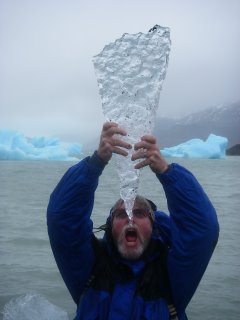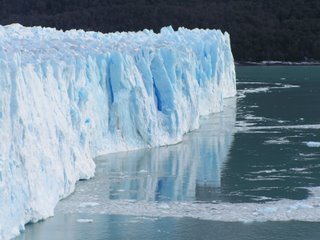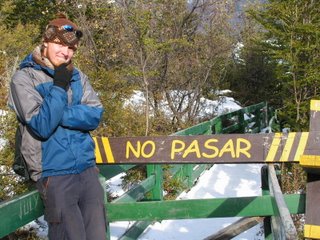Surreal... Bizarre... Freaky... Otherworldly-ish... I´m still searching for the best word to describe the scenery of southern Bolivia. For the last three days I´ve been bouncing around in a Land Cruiser, periodically stopping to be blown away by some new place or thing. Sometimes we actually were almost blown away... the wind was howling strong enough to be responsible for carving out rock formations like these:
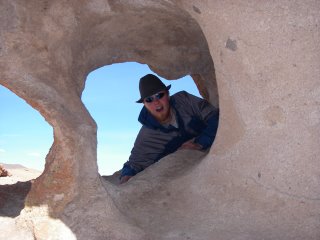
Welcome to the Desert of Salvador Dali... you know, the guy who painted the crazy landscapes and melting clocks and such. Any place named after him has gotta be weird.

El Arbol de Píedra -- the Tree of Rock. Watch out for falling fruit.

At times, even gravity itself was distorted, through some sort of bizarre space-time vortex.

The spacial distortions were't limited to Dali´s Desert, though... we also encountered them in the Salar, where it seems that a person's size increased according to how bad their body odor was at that point in the trip.
The Salar de Uyuni is a massive salt flat, twice as big as Utah´s Great Salt Lake. It may look like a snowy field, but it´s actually about 10 billion tons of salt, over ten meters thick in places. In the wet season the Salar is covered by a few inches of slushy, very salty water, but in the dry season (now) it´s just thousands of square miles of salt crystals. Salt crystals that taste just like regular salt, if you were wondering.

We visited a hotel made entirely of blocks of salt... walls, beds, tables, chairs... you´d just better hope it doesn´t rain.
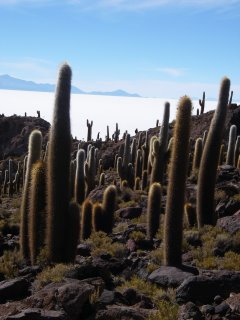
In keeping with the trip´s theme of ¨Really, Really Weird,¨ we also visited a tiny ¨island¨ in the middle of the flats. It was completely covered in cactus, some as much as 40 feet high. And what do you think it was called? Something logical and obvious, like ¨The Island of Salt¨ or ¨The Island of Cactus¨? Nope. It was named ¨El Isla del Pescado¨ -- The Island of Fish. Why? You got me. Even if there were fish in the ¨lake,¨ why name the island -- a piece of land -- after fish? Sheesh.

Our group, with our Land Rover. I have no idea how our driver figured out where we were going... once we got out in the middle of the Salar, every direction was a perfectly flat, completely featureless expanse of blinding white.
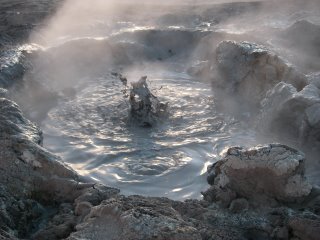
After the Salar, we visited geysers, bubbling mud baths...

...and hot springs that drained into frozen lakes. Remember, it´s winter down here. And parts of our excursion were over 4,600 meters. At that altitude, it gets pretty darn chilly at night. Somewhere between 0 and -20 (that´s negative 20) degrees Fahrenheit, in fact. The hot spring dip pictured above took place at 8 AM... It was still decidedly frigid when we had to drag ourselves out of the toasty water.

Our group, bundled up tight for an evening of cards. We had shelter each night, but they were unheated and somewhat open-air... by around 8 or 9, it was too frigid for much except heading to bed to huddle under as many blankets as possible.
 Next stop was a bright red lake (that´s water, not sand or mud). This lake was surrounded by 20-foot high mounds of borax. And it was populated by flamingos. Sure. Flamingos. Why not.
Next stop was a bright red lake (that´s water, not sand or mud). This lake was surrounded by 20-foot high mounds of borax. And it was populated by flamingos. Sure. Flamingos. Why not.

I almost forgot... there were llamas too. With pink ribbons.

Last but not least... we visited a train graveyard...
(Note that some very well-educated vandal has kindly inscribed Einstein´s Field Equation on the old hulk, neglecting neither the Ricci tensor nor the Universal Gravitational Constant.)

...and a people graveyard as well. This was no ordinary graveyard, though. There were dozens of 800-year-old skeletons lying around. Literally lying around, all over the place. Their relatives had chipped tombs out of some of the bizarrely eroded rocks in the area, but by now many of the tombs have been broken open, either by natural or human actions.

Here, you can see three tombs; the one on the right has the skeleton visible. The craziest part? This wasn´t in some fenced-in museum or ¨historical park¨or whatever. It was on a random hillside, in the middle of nowhere. There was one guy at the bottom of the hill to collect about 50 cents admission, and after that you were free to wander around, peeking into tombs and stepping over human remains where necessary. No rules Bolivia, as we´ve come to call it.
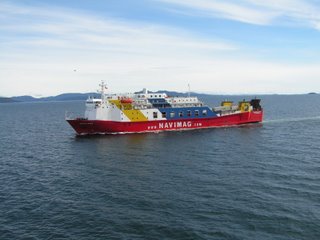

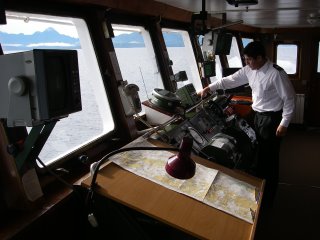
 The best part of the trip was the coffee-in-bed room service... delivered with a smile by Mr. Early Riser himself: dear old Dad. He saw more sunrises that trip than anyone else on board. I saw them too... for a few seconds. Out the porthole. From my bunk. Right after Mr. Cheerful woke me up to see them. Then I went back to sleep for another couple of hours. Hey, we were recovering from the brutal Patagonian winter, remember?
The best part of the trip was the coffee-in-bed room service... delivered with a smile by Mr. Early Riser himself: dear old Dad. He saw more sunrises that trip than anyone else on board. I saw them too... for a few seconds. Out the porthole. From my bunk. Right after Mr. Cheerful woke me up to see them. Then I went back to sleep for another couple of hours. Hey, we were recovering from the brutal Patagonian winter, remember? 





 Cloudy, too, which interfered with some of our sightseeing... there were still plenty of spectacular views, though.
Cloudy, too, which interfered with some of our sightseeing... there were still plenty of spectacular views, though. 


